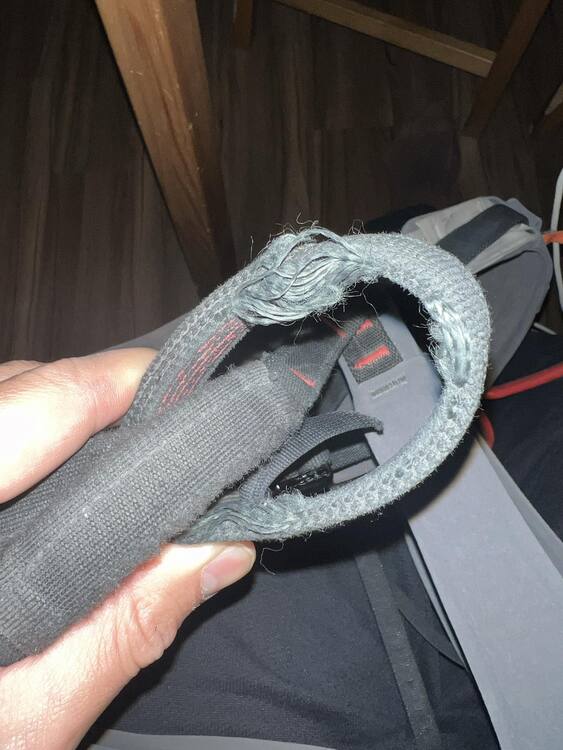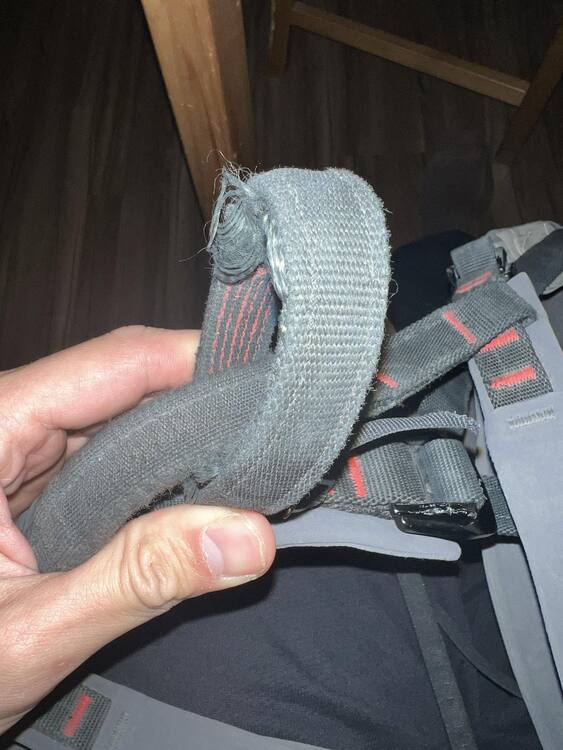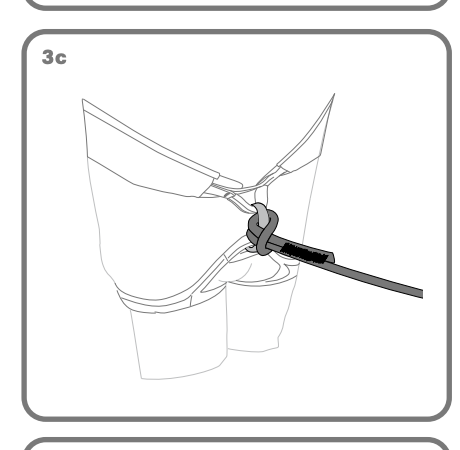Edelrid switch adjust danger issue
|
|
I have used the switch adjust (SA) extensively since its release last year, and I've noticed a significant issue that haven't been addressed by anyone, including Edelrid. Girth hitching around the belay loop, as recommended in the manual, is problematic. We are aware of incidents where using PAS systems or daisy chains with a girth hitch around the belay loop has led to fatalities due to excessive wear in one spot without moving it. The SA pinches too tightly, and the loop for removing it from the harness is so minimal that practically no one, myself included, removes it. I've often struggled to take off the SA because of how tight it is, so I end up leaving it on. While it's suggested to "move it" around periodically to avoid wear in the same spot, this doesn't work. The SA always shifts back to the same position. The bar tack consistently sits behind the tie-in points, and the SA moves to the top of the loop during use. This has severely deformed my belay loop, forcing me to replace my old harness due to unusual wear. How has this issue not been raised before, and why is Edelrid still unaware of it? https://avs.edelrid.com/images/attribut/54625_GAL_SWITCH_SPORT_ANSICHT_DINA4_Homepage.pdf |
|
|
Initially, I couldn't believe what happened to the belay loop on my Arc'teryx harness, which I've had for about 1-2 years. I hadn't noticed any issues before, and I only use the belay loop for belaying—I've never subjected it to extreme stress, like riding the pig with a 100 bag. Skeptical, I bought the exact same harness a couple of months ago, attached SA to it, and after just a few uses, the loop started to fray at the spot where the top girth hitch is. |
|
|
Never girth-hitch any load-bearing sling to the belay loop! For one thing, doing so compromises strength because of the extremely tight bend around a semi-sharp loop, not to mention the wear described by the OP. Instead, go through the tie-in path (hard points) of the harness. The AMGA has also preached girth-hitching the belay loop, which has further weakened its credibility. |
|
|
My counter anecdotal evidence is that I have girth-hitched Dyneema slings, Aramid slings, Petzl adjusts (single and dual), and daisy chains (aid) to my belay loops for years and have had no issues whatsoever. |
|
|
This would likely happen with any PAS type system after extensive use. Going through the tie in points is a good alternative. |
|
|
Ben Podborski wrote: John Sherman did that and had a near miss when his girth-hitched sling broke. |
|
|
I know that some other PAS manufacturers recommend attaching to the belay loop, but in Edelrid's case it may just be a German thing. I've climbed there and more than half of climbers I saw tied into the rope through the loop and not the hard points. A PAS attached to the belay loop is a terrible idea at hanging belays where the belay device behaves very differently when attached to a weighted loop. Geometry based ABDs may not work correctly. |
|
|
Uknown Unknown wrote: Have you contacted Edelrid? |
|
|
George Bracksieck wrote: What will the reduced strength of a sling be when girth hitched to a belay loop, and how does that compare to the strength of other elements in the typical system (belay device, rope, protection, my spine)? |
|
|
^^^^^^^^ In the real world, some slings are thinner and/or more fragile than others. Some belay loops are thinner, harder, and/or sharper than others. Tie-on paths vary in geometry, based on how the harnesses fit bodies of different sizes and rises. Mammut sells a harness that has plastic protecting and smoothing the tie-in path so that the leg loops and belay loop are less likely to saw through each other and create a Todd Skinner situation, although the smoothness may slightly facilitate acceleration and therefore increase the impact force. Data from standardized tests would have to be taken with a lot of caveats Girth-hitching through the tie-in path would definitely help absorb more impact if you were to factor-2 with the sling attached to the anchor, helping to protect your spine. |
|
|
The message I've long absorbed is that the problem isn't so much that girth hitching items through your belay loop is a path to certain doom, but rather that leaving the item more or less permanently in place where it will generate constant friction in a single spot is a poor choice. It seems that OP is describing exactly that. So, um, stop. Don't do that. I think the never girth hitch your belay loop thing is right up there with don't knot dyneema in the realm of overblown climbing dogma. |
|
|
WF WF51 wrote: I have just sent out an email to them about this, with the same information. Even if you try to girth hitch it around the tie in points, that doesn't even work, the bar tack is so thick that it does not sit properly, and feels like it's ripping the tie in points out. I'll keep you guys updated on their response. |
|
|
The bottomline is inspect you gear regularly. We all get complacent. Unfortunately, sometimes the reminders to do so are because of an accident. I find it interesting that some mfg recommend girth hitching to the belay loop others recommend girth hitching to the tie in points. |
|
|
George Bracksieck wrote: Without test data, how can you advise everyone not to girth hitch to their belay loop? It’s true that girth hitches reduce strength, but slings are so strong that even at reduced strength they are perfectly adequate. A 50% strength sling is as strong as a climbing rope, or a belay device, or trad gear. There’s no reason to create unnecessary fear around the strength reduction. |
|
|
Kyle Tarry wrote: The absence of test data doesn’t mean that there’s no evidence. The OP’s experience is a data point. John Sherman had a rude awakening when his girth-hitched sling failed, which is another data point. I recall reading that a climber fell to his death after his dyneema sling broke when he factor-twoed onto a bolted anchor, after which MP lurkers started taking about using dynamic rope for tethers—yet another data point if said sling was girth-hitched to the belay loop. Girth-hitching through the tie-in path could make all the difference by making a softer catch. Saying that a lack of test data means that a problem doesn’t exist is like saying that something didn’t happen because I don’t have a selfie to prove it. This isn’t about spreading fear; it’s about information. Valid information exists outside of nonexistent test data. If you want to onsight free-solo Lurking Fear because there are no test data to suggest that you may not succeed, it’s your choice. |
|
|
I use a Swing for a PAS, Don’t remember what the instructions said (either girthed to belay loop or hard points), but I think both options have drawbacks. My solution is a Petzl Ring through the hard points and through the eye at the end of the PAS. Skips the girth hitch all together and doesn’t squeeze the hard points together as much when weighted. No potential to cross load. |
|
|
George Bracksieck wrote: You're talking about a lot of different failure modes above, I was only commenting on the strength aspect. A "reduced strength" personal tether (still likely 12+ kN based on the data) isn't a hazard. A factor-2 onto a static tether, or a worn out belay loop because a tether has been permanently installed, are different problems, and definitely things people should be aware of.
It seems like a stretch to me that this would provide a meaningfully softer catch, or that it would result in a significantly stronger connection. I don't think we should make claims about safety that aren't robustly supported. |
|
|
George Bracksieck wrote: No it couldn't, that's not a thing. |
|
|
If anything this seems more likely to be related to the Arc'teryx belay loop rather than the Edelrid specific tether (any brand of tether could cause similar wear). The Arc' belay loops and tie in points are notorious for wearing out faster than other harnesses. Other companies have switched to different materials for the tie ins and belay loop to increase wear resistance i.e. Petzl. |
|
|
Girth hitching through the master points means a lot less air around the nads. For high waisted females might be even worse. |
|
|
George Bracksieck wrote: Is this a joke? There’s absolutely nothing unsafe about GH’ing to the belay loop. There’s also one accident ever that *may* have been attributed to this, with Todd Skinner, but various reports abound as to how much was just general harness wear. Regardless, there is absolutely nothing unsafe about girth hitching a sling or a PAS through the belay loop. |

 Continue with onX Maps
Continue with onX Maps Sign in with Facebook
Sign in with Facebook


























